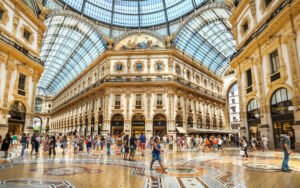Top Things to Do on a Luxury Vacation in Milan

A Luxury Getaway in Milan: Top Things to Do
Imagine strolling through Milan’s glamorous streets, surrounded by world-class fashion boutiques and iconic landmarks. As a city synonymous with Italian elegance, Milan offers an unforgettable luxury vacation experience. From the grandeur of the Duomo to the vibrant energy of the Galleria Vittorio Emanuele II, this city caters to the discerning traveler seeking the finest that Italy has to offer. Join us as we unveil our recommendations for the top things to do on a luxury vacation in Milan, including hidden gems and insider tips that will make your trip truly unforgettable.

Indulge in High-End Shopping
Milan is a shopper’s paradise, with the Quadrilatero della Moda being a must-visit. This exclusive district is home to renowned brands like Prada, Gucci, Armani, and Versace. For a truly personalized experience, consider taking advantage of personal shopping services and private showings.
The Galleria Vittorio Emanuele II is another iconic shopping destination, offering a stunning glass-roofed arcade with a wide range of luxury brands.

Immerse Yourself in Art and Culture
- The Last Supper: A masterpiece by Leonardo da Vinci, located in the Convent of Santa Maria delle Grazie.
- Teatro alla Scala: One of the world’s most renowned opera houses, offering a captivating cultural experience.

Explore Majestic Architecture
- Duomo di Milano: A Gothic masterpiece with intricate spires and ornate façade.
- Sforza Castle: A historic fortress housing several museums and art galleries.

Savor Exquisite Cuisine
- Michelin-starred restaurants: Indulge in culinary masterpieces at renowned establishments.
- Historic trattorias: Experience traditional Milanese flavors in a timeless setting.
- Aperitivo: Enjoy a pre-dinner ritual of drinks and snacks.

Experience the Luxurious Lifestyle
World-class spa treatments: Pamper yourself at luxurious spas like the Armani Spa or Four Seasons Spa.
Private tours: Explore Milan with a personal guide for a tailored experience.

Discover Hidden Gems
- Brera: A bohemian neighborhood with art galleries, antique shops, and cozy cafes.
- Navigli: A vibrant area with canals, bars, and restaurants.

Milan for Families
- Leonardo da Vinci National Museum of Science and Technology: An interactive museum for curious minds.
- Acquario Civico: Explore the underwater world at Milan’s civic aquarium.
- Indro Montanelli Public Gardens: Enjoy a leisurely stroll and visit the planetarium.

Elevate Your Stay
- Luxury accommodations: Choose from historic palaces, modern masterpieces, or stylish boutique hotels.
Milan offers a wealth of luxurious experiences for all types of travelers. Whether you’re exploring its rich history, indulging in its culinary delights, or simply soaking in the atmosphere, your Milanese adventure is sure to be unforgettable.
Plan Your Luxury Getaway
Let our expert Italian Travel Advisors help you create a personalized itinerary tailored to your specific interests and preferences. From exclusive accommodations to private tours, we’ll ensure that your Milan experience is nothing short of extraordinary.


